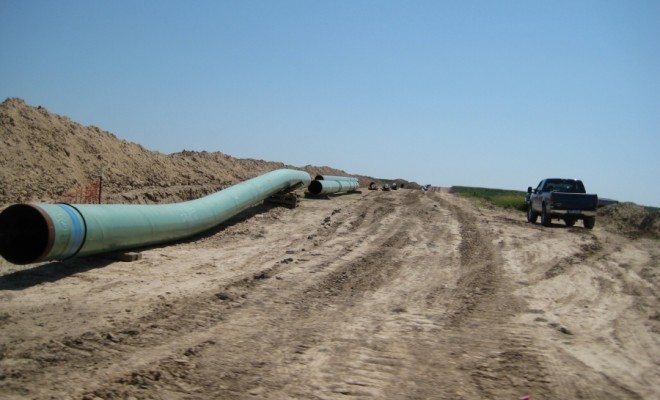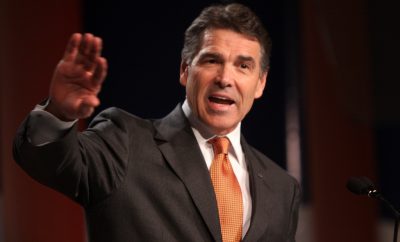 Image courtesy of [shannonpatrick17 via Flickr]
Image courtesy of [shannonpatrick17 via Flickr]
Energy & Environment
The Keystone XL Pipeline: Economic Breakthrough or Environmental Disaster?
Since November 2014 when Republicans won control of the Senate and maintained control of the House, there have been promises that many hot topics will get attention. One of the first on the list was the issue of the Keystone XL Pipeline. While the political status of the bill is still up in the air, read on to learn about what the Keystone XL Pipeline is, and the political arguments for and against it.
What is the Keystone XL Pipeline?
The Keystone XL Pipeline is a pipeline transport that is to start in the town of Hardisty in Eastern Alberta, Canada and extend southeast to Steele City, Nebraska. The goal of the pipeline is to help transport crude oil from Canada to the Gulf Coast in Texas, and to help move oil from the Bakkan region in North Dakota and Montana to places where it can be used.
The pipeline would actually be an extension to the current Keystone pipeline that already runs from Hardisty to the town of Patoka, Illinois. That’s the reason that it’s called “XL”–it’s an extension to the current operation. When running at full capacity, the Keystone XL will be able to handle up to 830,000 barrels of crude oil per day. The video below explains the purpose of the Keystone XL Pipeline.
In order for the Keystone XL Pipeline to become a reality, Trans Canada has to receive approval from the President due to the fact that the project crosses into the United States from Canada. But since the Constitution states that the President cannot make the laws, and that Congress has to create a law or bill for the pipeline to be built, the issue has been languishing in Congress.
What is the Keystone XL Pipeline’s current status?
The authority to build the Keystone XL pipeline is currently the focus of two versions of a bill in the House and the Senate. The two versions need to become one bill, which will force members from both houses of Congress to work together. The biggest difference between the two bills are the amendments that have been tacked on, particularly on the Senate side. For example, the Senate, which passed its version of the bill on January 29, 2015, added on amendments that protect landowners from the use of eminent demand. The House version of the bill passed on January 9, 2015.
What is the next step for the Keystone XL Pipeline bill?
The House has said it will pass the Senate version soon, so the bill will go to President Obama’s desk for his signature; however, the White House has stated that Obama will veto the Keystone XL Pipeline Bill if it comes to his desk. If this happens, the bill will go back to Congress where a two-thirds majority will be needed to override the president;s veto. If that majority is reached, the pipeline will become a reality. If majority is not reached, the bill will go back to Congress where they will have to hammer out something else.
What are the arguments in favor of passing the Keystone XL Pipeline?
The Economic Argument
Some proponents who would like to see the Keystone XL Pipeline become reality argue that it will create jobs for Americans. The American Petroleum Institute stated that 42,000 American jobs are at stake. While exactly how many jobs would be gained through the construction, maintenance, and operation of the pipelines is difficult to estimate, it’s certain that manpower would be needed for each of these steps. The United States Chamber of Commerce stated that on its Keystone XL Pipeline Lost Opportunity Tour it encountered numerous business owners, civic leaders, and citizens who will benefit from construction of the pipeline, as the jobs it creates will stimulate other parts of the economy.
The Safety Argument
Trans-Canada, the company that will be building the pipeline, emphasizes the safety benefits. It points to the existing Keystone Pipeline that has safely transported more than 700 million barrels of the same oil to U.S. refineries since 2010 as proof of its commitment to safety and the amount of oil that it has successfully moved already. It argues that a pipeline is the safest way to move oil and natural gas. According to a recent Frasier study, there are fewer accidents with pipeline transport than with trains or trucks. Furthermore it points out that five studies and 20,000 pages of scientific review have led the U.S. State Department to conclude that the project can be built and operated with minimal environmental impact.
Energy Independence
One political concern that has deepened in recent years is the worry that the United States relies too much on outside producers for oil, gas, and other forms of energy. While the amount of oil that we import from OPEC countries has gone down over the years, we still do import significant amounts of oil from the Middle East. While the new pipeline means that we will still be importing oil, it will be from Canada, our consistent ally. Those who emphasize the need for energy independence point out that this development would allow the U.S. to separate its economic relationships from its political relationships in world affairs.

Image courtesy of Tar Sands Blockade via Flickr
What are the arguments against the Keystone XL Pipeline passing?
The Environmental Argument
Those who oppose the Keystone XL Pipeline include environmental groups, such as the Sierra Club, Friends of the Earth, and The National Resources Defense Council. In fact, the National Resources Defense council stated that “this pipeline will lock the United States into a dependence on hard-to-extract oil and generate a massive expansion of the destructive tar sands oil operations in Canada.” Environmentalists worry that “in addition to the damage that would be caused by the increased tar sands extraction, the pipeline threatens to pollute freshwater supplies in America’s agricultural heartland and increase emissions in already-polluted communities of the Gulf Coast.”
Further arguments against the pipeline come from a group of Nobel Peace Prize Laureates including former president Jimmy Carter and Archbishop Desmond Tutu, who state that the tar sands are “among the world’s most polluting oil” and their growth in Northern Alberta has high costs for the climate. They also stress that the Keystone XL pipeline is the “linchpin for tar sands expansion and the increased pollution that will follow.” The result of the increase in pollution will trigger “more climate upheaval with impacts felt around the world.”
Former Vice President Al Gore stated in his blog that the tar sands are the “dirtiest source of liquid fuel on the planet” and this pipeline would be an “enormous mistake.” Those who agree with Gore believe that the “answer to our climate, energy, and economic challenges does not lie in burning more dirty fossil fuels” but in more “rapid development of renewable energy and energy-efficient technologies.”
The Dependency Argument
Senator Bernie Sanders, an Independent Senator from Vermont, made the case back in 2014 that the Keystone XL Pipeline would move America in the wrong direction as instead of making us greener, it would make America more dependent on nonrenewable resources. Proponents of the dependency argument point out that even though we may become less dependent on foreign producers of oil, we would become more dependent on crude oil and natural gas as energy forms. Instead of exploring other energy options, such as solar or wind power, we would continue to rely on nonrenewable resources. Those who are worried about this dependency argue that we could create jobs and energy by focusing on these alternate types of energy.
The Health Argument
Senator Barbara Boxer (D-CA) explained this school of thought well in a recent speech in the Senate. She reminded everyone that the oil being transported would be tar sand oil, not the conventional crude that we are used to hearing about on the news. Tar sand oil contains 11 times more sulfur and nickel, six times more nitrogen, and five times more lead. Sulfur dioxide can penetrate deeply into sensitive parts of the lungs and cause respiratory diseases such as Emphysema and Bronchitis, while an influx of nitrogen dioxide can increase symptoms in people with Asthma. According to this argument, these problems will increase in areas affected by the pipeline.
Conclusion
The Keystone XL Pipeline is a massive pipe that will run from Canada to Nebraska and link up with other pipelines to get oil down to refineries in Texas. Bills have passed the House and Senate; however, the bills will need to be made into one large bill that will pass Congress jointly in order to be sent to President Obama’s desk.This process has been made difficult by the storm of criticism that has come from both sides of the argument on whether or not a pipeline should cross the American heartland.
Resources
Primary
Senate: Keystone Pipeline XL Bill
House of Representatives: Keystone Pipeline XL Bill
Additional
TransCanada: About the Project
American Petroleum Institute: API Applauds Swift Senate Action on Keystone XL
John Hoeven: Statement on Keystone XL
Think Progress: Find Out How Your Senator Voted on the Keystone XL Pipeline
John Manchin: Statement on Keystone XL
Al Gore: The Dirtiest Fuel on the Planet
Nobel Women’s Initiative: Nobel Laureates Urge Obama to Deny Keystone XL Tar Sands Pipeline
Editor’s Note: This post has been updated to credit certain information to Al Gore’s blog.








Comments